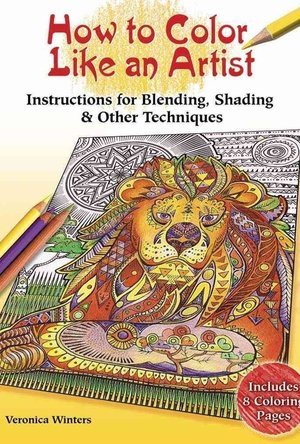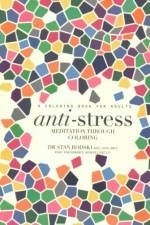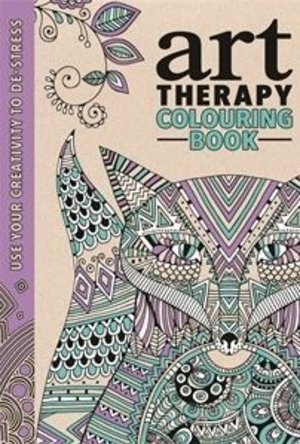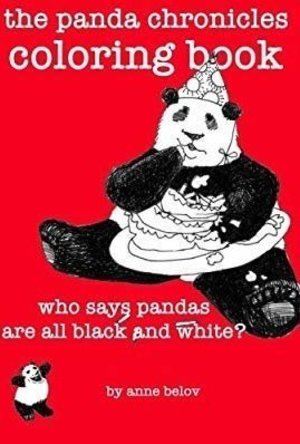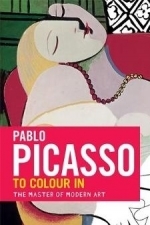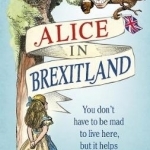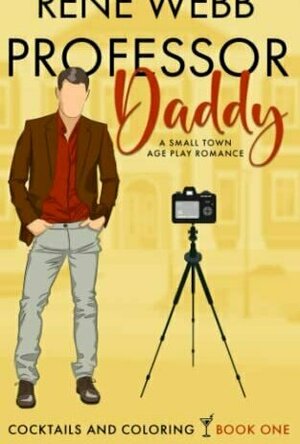Search
Search results
Colouring just got serious! An excellent book
Clare Parrott (294 KP) rated Meditations Through Coloring in Books
Feb 13, 2018
Colouring books for adults are all the rage at the moment. This is a nice book with varying degrees of difficulty. 96 black and white pages for you to run riot on. I received and e copy of the book so I'm unable to comment on the page quality.
Hazel (1853 KP) rated The Art Therapy Colouring Book in Books
Dec 14, 2018
Doodle and colour your stress away!
See <a href="https://hazelstainer.wordpress.com/2016/02/12/art-therapy-an-anti-stress-colouring-book/">here</a>; and <a href="https://hazelstainer.wordpress.com/2016/04/01/a-middle-fingers-perspective/">here</a>; for image examples:
I was given a copy of this colouring book, Art Therapy, for Christmas a couple of years ago, before they became the latest craze. It was not until during the past half a year that I seriously got into colouring. Some people scoff and ridicule the idea that colouring can relieve stress, however, in my experience, it really can!
This particular book contains drawings from three different illustrators: Hannah Davies, Richard Merritt and Cindy Wilde; however you would not know it as all the pages are a similar style. The images range from animals, flowers and objects, to basic and complicated patterns.
With hundreds of colouring books to choose from, what makes Art Therapy, and others from the same series, different from the rest? Firstly, most of the patterns have been started for you. Some people may argue this is a negative point, yet I find it quite useful. I use the starting colours as a theme to stick to throughout the page (see above for examples). I like structure and rule following therefore this is a great book for me. Secondly, the book is split into to halves: images and patterns to colour in, and unfinished images and patterns. The second part of the book allows the owner of the book to finish the outlines of the colouring pages however they wish before colouring them in. This helps to nurture and develop illustration skills. I have not attempted these pages yet as I am moving through the book methodically (I did say I like structure and rule following!), I will post examples at a later date.
The paper quality is extremely good, a lot better than many other colouring books I have come across. Even though I do not use them (I only use pencils), this book should be suitable for felt tip pens – although I would avoid Sharpies, they go through everything!
Now the downside… it is a hardback. Not the easiest to colour in with it on your lap whilst watching television (although I manage some how). I have only completed 21 pages so far and I am already worried that it is going to fall apart. Having said that, the other day I noticed that The Works were selling a paper back version! Perhaps invest in that format if you are thinking of buying this book.
See <a href="https://hazelstainer.wordpress.com/2016/02/12/art-therapy-an-anti-stress-colouring-book/">here</a>; and <a href="https://hazelstainer.wordpress.com/2016/04/01/a-middle-fingers-perspective/">here</a>; for image examples:
I was given a copy of this colouring book, Art Therapy, for Christmas a couple of years ago, before they became the latest craze. It was not until during the past half a year that I seriously got into colouring. Some people scoff and ridicule the idea that colouring can relieve stress, however, in my experience, it really can!
This particular book contains drawings from three different illustrators: Hannah Davies, Richard Merritt and Cindy Wilde; however you would not know it as all the pages are a similar style. The images range from animals, flowers and objects, to basic and complicated patterns.
With hundreds of colouring books to choose from, what makes Art Therapy, and others from the same series, different from the rest? Firstly, most of the patterns have been started for you. Some people may argue this is a negative point, yet I find it quite useful. I use the starting colours as a theme to stick to throughout the page (see above for examples). I like structure and rule following therefore this is a great book for me. Secondly, the book is split into to halves: images and patterns to colour in, and unfinished images and patterns. The second part of the book allows the owner of the book to finish the outlines of the colouring pages however they wish before colouring them in. This helps to nurture and develop illustration skills. I have not attempted these pages yet as I am moving through the book methodically (I did say I like structure and rule following!), I will post examples at a later date.
The paper quality is extremely good, a lot better than many other colouring books I have come across. Even though I do not use them (I only use pencils), this book should be suitable for felt tip pens – although I would avoid Sharpies, they go through everything!
Now the downside… it is a hardback. Not the easiest to colour in with it on your lap whilst watching television (although I manage some how). I have only completed 21 pages so far and I am already worried that it is going to fall apart. Having said that, the other day I noticed that The Works were selling a paper back version! Perhaps invest in that format if you are thinking of buying this book.
Hazel (1853 KP) rated Where's Wally? The Colouring Book in Books
Dec 17, 2018
https://hazelstainer.wordpress.com/2016/07/08/wheres-wally-the-colouring-book/
“The ultimate colouring challenge!”
Everyone knows who Wally is. Created by Martin Handford, Wally first appeared in the book <i>Where’s Wally?</i> in 1987, and has since become famous throughout the world. The aim of the book is to locate Wally and all of his friends in numerous crowded, hand-drawn scenes.
Whilst the colouring book franchise is taking the world by storm, what better time to release a <i>Where’s Wally?</i> colouring book? The idea is the same as the previous Handford publications, in that the ultimate aim is to find Wally; however in this instance it is also left up to you to add the colour to the scenes.
<i>Where’s Wally?</i> fans will recognize many of the drawings from the original books, and therefore will already know where Wally is hiding – but it is much harder to spot him without his traditional red and white stripes being shaded in.
There are twenty-seven double-paged scenes to colour in and keep you entertained for hours. Those familiar with Handford’s illustrations will be aware of the detail he includes; and yes, you are meant to colour ALL of it! This colouring book will definitely take you a while to complete. The downside to such detailed pages is that there are so many tiny elements to add colour to. You will need to keep your pencils sharpened and sit in a well-lit area.
The pages are quite thick, but as they are double sided I would be wary of using felt-tip pens. Perhaps test them on the title page first to make sure they do not bleed through to the other side. Also, only fine tipped pens will be suitable in order to stay within the lines.
Many people believe that colouring is childish, but this book proves otherwise. You will need lots of control and patience in order to finish this book. Good luck.
“The ultimate colouring challenge!”
Everyone knows who Wally is. Created by Martin Handford, Wally first appeared in the book <i>Where’s Wally?</i> in 1987, and has since become famous throughout the world. The aim of the book is to locate Wally and all of his friends in numerous crowded, hand-drawn scenes.
Whilst the colouring book franchise is taking the world by storm, what better time to release a <i>Where’s Wally?</i> colouring book? The idea is the same as the previous Handford publications, in that the ultimate aim is to find Wally; however in this instance it is also left up to you to add the colour to the scenes.
<i>Where’s Wally?</i> fans will recognize many of the drawings from the original books, and therefore will already know where Wally is hiding – but it is much harder to spot him without his traditional red and white stripes being shaded in.
There are twenty-seven double-paged scenes to colour in and keep you entertained for hours. Those familiar with Handford’s illustrations will be aware of the detail he includes; and yes, you are meant to colour ALL of it! This colouring book will definitely take you a while to complete. The downside to such detailed pages is that there are so many tiny elements to add colour to. You will need to keep your pencils sharpened and sit in a well-lit area.
The pages are quite thick, but as they are double sided I would be wary of using felt-tip pens. Perhaps test them on the title page first to make sure they do not bleed through to the other side. Also, only fine tipped pens will be suitable in order to stay within the lines.
Many people believe that colouring is childish, but this book proves otherwise. You will need lots of control and patience in order to finish this book. Good luck.
Hazel (1853 KP) rated The Panda Chronicles Coloring Book in Books
Dec 14, 2018
Review with image example can be found here: https://hazelstainer.wordpress.com/2016/07/15/who-says-pandas-are-black-and-white/
Who says pandas are all black and white?
Anne Belov is a satirical cartoonist with an obsession for pandas. She has published several books in <i>The Panda Chronicles</i> and has now produced a colouring book to go with the series. Pandas may seem like a peculiar subject for a colouring book since they are, as Belov puts it, “chromatically challenged,” however the world around them is bursting with different tints and shades.
The pandas featured in <i>The Panda Chronicles</i> are not the typical bears you might see in a zoo, or endangered in the wild. Anne Belov’s pandas get up to all sorts of mischief. In this colouring book you can expect to find pandas in all sorts of locations, wearing a variety of odd outfits, taking part in highly suspicious activities. So despite monochromatic fur, there is so much to add colour to.
<i>The Panda Chronicles Colouring Book</i> contains approximately 60 single sided illustrations. Although the paper feels quite thin, the lack of anything on the reverse means that it is safe to use any medium you wish to fill the drawing with colour.
Belov’s drawing approach is not the typical style of the hundreds of colouring books you see in stores – i.e. thick, precise lines and patterns. Belov sticks to her sketchy manner that she has used in all the chronicles thus far. In fact there is reason to believe (although do not quote this) that many of the illustrations are from the original books. While standing out in such a niche market, these particular pages may be more difficult to colour in. Some contain many scribbles rather than clear objects, however that does not detract from the overall fun guaranteed with this book.
Pandas in unconventional settings are a great cause for hilarity and satire. Not only is it funny that these bears are parodying human life, but the things they are up to are highly amusing. One particularly comical scene contains a mother panda telling her child off for being the cause of the <b>LEANING</b> Tower of Pisa, to which the youngster protests, “I didn’t do it! It was leaning when we got here!” The wittiness continues throughout the remainder of the book.
I bought this book hoping it would be suitable for my “pandamaniac” friend, who on occasion tells farcical stories about her (imaginary) friend <i>Miss Panda</i>. Anne Belov’s colouring book is the absolutely perfect present for her. It is almost as if the scenes are written/drawn about <i>Miss Panda</i> herself, despite the artist and my friend having never met… Unless… oh the horror! Maybe <i>Miss Panda</i> IS real!
Who says pandas are all black and white?
Anne Belov is a satirical cartoonist with an obsession for pandas. She has published several books in <i>The Panda Chronicles</i> and has now produced a colouring book to go with the series. Pandas may seem like a peculiar subject for a colouring book since they are, as Belov puts it, “chromatically challenged,” however the world around them is bursting with different tints and shades.
The pandas featured in <i>The Panda Chronicles</i> are not the typical bears you might see in a zoo, or endangered in the wild. Anne Belov’s pandas get up to all sorts of mischief. In this colouring book you can expect to find pandas in all sorts of locations, wearing a variety of odd outfits, taking part in highly suspicious activities. So despite monochromatic fur, there is so much to add colour to.
<i>The Panda Chronicles Colouring Book</i> contains approximately 60 single sided illustrations. Although the paper feels quite thin, the lack of anything on the reverse means that it is safe to use any medium you wish to fill the drawing with colour.
Belov’s drawing approach is not the typical style of the hundreds of colouring books you see in stores – i.e. thick, precise lines and patterns. Belov sticks to her sketchy manner that she has used in all the chronicles thus far. In fact there is reason to believe (although do not quote this) that many of the illustrations are from the original books. While standing out in such a niche market, these particular pages may be more difficult to colour in. Some contain many scribbles rather than clear objects, however that does not detract from the overall fun guaranteed with this book.
Pandas in unconventional settings are a great cause for hilarity and satire. Not only is it funny that these bears are parodying human life, but the things they are up to are highly amusing. One particularly comical scene contains a mother panda telling her child off for being the cause of the <b>LEANING</b> Tower of Pisa, to which the youngster protests, “I didn’t do it! It was leaning when we got here!” The wittiness continues throughout the remainder of the book.
I bought this book hoping it would be suitable for my “pandamaniac” friend, who on occasion tells farcical stories about her (imaginary) friend <i>Miss Panda</i>. Anne Belov’s colouring book is the absolutely perfect present for her. It is almost as if the scenes are written/drawn about <i>Miss Panda</i> herself, despite the artist and my friend having never met… Unless… oh the horror! Maybe <i>Miss Panda</i> IS real!
Hazel (1853 KP) rated Picasso: The Colouring Book in Books
Jul 15, 2017
Educational and Fun
For a full review, including visual examples, please follow this link: https://hazelstainer.wordpress.com/20...
...
Pablo Picasso: To Colour In was published in April 2016 with the intention of using the popular fad to educate readers/colouring book enthusiasts about the techniques and secrets of the great master. Each work included in the book has a brief paragraph explaining what it is (in case you cannot tell) and a few details about Picasso’s intentions or the events happening in his life at the time.
...
Naturally, it would be impossible to produce a book of all Picasso’s recorded works, but the editors of this particular colouring book have carefully selected examples that span the majority of his life, thus encompassing the different styles he experimented with.
The author of the text – presumably Frédérique Cassegrain, who also wrote the biography and information for each included artwork – gives helpful advice about how to colour in the outlined versions of Picasso’s paintings. The paper is thick enough to be suitable for paints, particular Gouache, which is water soluble and easily blended. Alternatively, coloured pencils may be used, preferably of artistic quality, which may be more suitable for those less confident in art and design. Another option, although not mentioned by the author, are felt-tip pens. Usually, these should be avoided due to ink bleeding through the page, however, the paper is single sided, so there is no chance of damaging the following colouring page in the book.
Purchasing Pablo Picasso: To Colour In and completing the book, provides not only hours of fun and relaxation, but an opportunity to discover and understand the artist. Unlike at a gallery where the brain may switch off, being able to go away and return to the book gives us time to absorb the information and concentrate more clearly on the details of each painting.
Opposite each colouring page is a copy of the original in full colour, meaning that, if one desired, one could replicate Picasso’s work as closely as possible. By doing, rather than just looking, we begin to understand the colour choices, piece together the geometric shapes to form an image and begin to understand the thought processes of the artist.
Interestingly, there are two paintings that stand out amongst all the others. These were produced during and after the First World War, a time when Picasso returned to a more classical style of artwork. These are The Pipes of Pan (1923) and The Bathers (1918). Both show a completely different side to Picasso and would not immediately be recognised as his own work. Despite not being entirely life-like, there are no elements of Cubism or Surrealism and the colour palette is altogether natural. Picasso has focused on shading and tone to create a realistic appearance, a contrast to the flattened portraits he is known for.
...
Pablo Picasso: To Colour In will appeal to artists, art historians and other creatives with its contrast of light relief and in-depth knowledge. The book is available online at retailers such as Amazon and The Book Depository from approximately £6. If Picasso is not your thing, there are other artists available in the series of colouring books, including Klimt, Hokusai (Japanese Art), Monet, Van Gogh, Caillebotte and Manet (Impressionists), and Paul Klee. Whatever your preference, prepare to learn whilst you are relaxing and having fun.
...
Pablo Picasso: To Colour In was published in April 2016 with the intention of using the popular fad to educate readers/colouring book enthusiasts about the techniques and secrets of the great master. Each work included in the book has a brief paragraph explaining what it is (in case you cannot tell) and a few details about Picasso’s intentions or the events happening in his life at the time.
...
Naturally, it would be impossible to produce a book of all Picasso’s recorded works, but the editors of this particular colouring book have carefully selected examples that span the majority of his life, thus encompassing the different styles he experimented with.
The author of the text – presumably Frédérique Cassegrain, who also wrote the biography and information for each included artwork – gives helpful advice about how to colour in the outlined versions of Picasso’s paintings. The paper is thick enough to be suitable for paints, particular Gouache, which is water soluble and easily blended. Alternatively, coloured pencils may be used, preferably of artistic quality, which may be more suitable for those less confident in art and design. Another option, although not mentioned by the author, are felt-tip pens. Usually, these should be avoided due to ink bleeding through the page, however, the paper is single sided, so there is no chance of damaging the following colouring page in the book.
Purchasing Pablo Picasso: To Colour In and completing the book, provides not only hours of fun and relaxation, but an opportunity to discover and understand the artist. Unlike at a gallery where the brain may switch off, being able to go away and return to the book gives us time to absorb the information and concentrate more clearly on the details of each painting.
Opposite each colouring page is a copy of the original in full colour, meaning that, if one desired, one could replicate Picasso’s work as closely as possible. By doing, rather than just looking, we begin to understand the colour choices, piece together the geometric shapes to form an image and begin to understand the thought processes of the artist.
Interestingly, there are two paintings that stand out amongst all the others. These were produced during and after the First World War, a time when Picasso returned to a more classical style of artwork. These are The Pipes of Pan (1923) and The Bathers (1918). Both show a completely different side to Picasso and would not immediately be recognised as his own work. Despite not being entirely life-like, there are no elements of Cubism or Surrealism and the colour palette is altogether natural. Picasso has focused on shading and tone to create a realistic appearance, a contrast to the flattened portraits he is known for.
...
Pablo Picasso: To Colour In will appeal to artists, art historians and other creatives with its contrast of light relief and in-depth knowledge. The book is available online at retailers such as Amazon and The Book Depository from approximately £6. If Picasso is not your thing, there are other artists available in the series of colouring books, including Klimt, Hokusai (Japanese Art), Monet, Van Gogh, Caillebotte and Manet (Impressionists), and Paul Klee. Whatever your preference, prepare to learn whilst you are relaxing and having fun.
Hazel (1853 KP) rated Picasso: The Colouring Book in Books
Dec 7, 2018
For a full review, including visual examples, please follow this link: https://hazelstainer.wordpress.com/2017/07/14/picasso-coloured-in/
...
<i>Pablo Picasso: To Colour In</i> was published in April 2016 with the intention of using the popular fad to educate readers/colouring book enthusiasts about the techniques and secrets of the great master. Each work included in the book has a brief paragraph explaining what it is (in case you cannot tell) and a few details about Picasso’s intentions or the events happening in his life at the time.
...
Naturally, it would be impossible to produce a book of all Picasso’s recorded works, but the editors of this particular colouring book have carefully selected examples that span the majority of his life, thus encompassing the different styles he experimented with.
The author of the text – presumably Frédérique Cassegrain, who also wrote the biography and information for each included artwork – gives helpful advice about how to colour in the outlined versions of Picasso’s paintings. The paper is thick enough to be suitable for paints, particular Gouache, which is water soluble and easily blended. Alternatively, coloured pencils may be used, preferably of artistic quality, which may be more suitable for those less confident in art and design. Another option, although not mentioned by the author, are felt-tip pens. Usually, these should be avoided due to ink bleeding through the page, however, the paper is single sided, so there is no chance of damaging the following colouring page in the book.
Purchasing Pablo Picasso: To Colour In and completing the book, provides not only hours of fun and relaxation, but an opportunity to discover and understand the artist. Unlike at a gallery where the brain may switch off, being able to go away and return to the book gives us time to absorb the information and concentrate more clearly on the details of each painting.
Opposite each colouring page is a copy of the original in full colour, meaning that, if one desired, one could replicate Picasso’s work as closely as possible. By doing, rather than just looking, we begin to understand the colour choices, piece together the geometric shapes to form an image and begin to understand the thought processes of the artist.
Interestingly, there are two paintings that stand out amongst all the others. These were produced during and after the First World War, a time when Picasso returned to a more classical style of artwork. These are The Pipes of Pan (1923) and The Bathers (1918). Both show a completely different side to Picasso and would not immediately be recognised as his own work. Despite not being entirely life-like, there are no elements of Cubism or Surrealism and the colour palette is altogether natural. Picasso has focused on shading and tone to create a realistic appearance, a contrast to the flattened portraits he is known for.
...
Pablo Picasso: To Colour In will appeal to artists, art historians and other creatives with its contrast of light relief and in-depth knowledge. The book is available online at retailers such as Amazon and The Book Depository from approximately £6. If Picasso is not your thing, there are other artists available in the series of colouring books, including Klimt, Hokusai (Japanese Art), Monet, Van Gogh, Caillebotte and Manet (Impressionists), and Paul Klee. Whatever your preference, prepare to learn whilst you are relaxing and having fun.
...
<i>Pablo Picasso: To Colour In</i> was published in April 2016 with the intention of using the popular fad to educate readers/colouring book enthusiasts about the techniques and secrets of the great master. Each work included in the book has a brief paragraph explaining what it is (in case you cannot tell) and a few details about Picasso’s intentions or the events happening in his life at the time.
...
Naturally, it would be impossible to produce a book of all Picasso’s recorded works, but the editors of this particular colouring book have carefully selected examples that span the majority of his life, thus encompassing the different styles he experimented with.
The author of the text – presumably Frédérique Cassegrain, who also wrote the biography and information for each included artwork – gives helpful advice about how to colour in the outlined versions of Picasso’s paintings. The paper is thick enough to be suitable for paints, particular Gouache, which is water soluble and easily blended. Alternatively, coloured pencils may be used, preferably of artistic quality, which may be more suitable for those less confident in art and design. Another option, although not mentioned by the author, are felt-tip pens. Usually, these should be avoided due to ink bleeding through the page, however, the paper is single sided, so there is no chance of damaging the following colouring page in the book.
Purchasing Pablo Picasso: To Colour In and completing the book, provides not only hours of fun and relaxation, but an opportunity to discover and understand the artist. Unlike at a gallery where the brain may switch off, being able to go away and return to the book gives us time to absorb the information and concentrate more clearly on the details of each painting.
Opposite each colouring page is a copy of the original in full colour, meaning that, if one desired, one could replicate Picasso’s work as closely as possible. By doing, rather than just looking, we begin to understand the colour choices, piece together the geometric shapes to form an image and begin to understand the thought processes of the artist.
Interestingly, there are two paintings that stand out amongst all the others. These were produced during and after the First World War, a time when Picasso returned to a more classical style of artwork. These are The Pipes of Pan (1923) and The Bathers (1918). Both show a completely different side to Picasso and would not immediately be recognised as his own work. Despite not being entirely life-like, there are no elements of Cubism or Surrealism and the colour palette is altogether natural. Picasso has focused on shading and tone to create a realistic appearance, a contrast to the flattened portraits he is known for.
...
Pablo Picasso: To Colour In will appeal to artists, art historians and other creatives with its contrast of light relief and in-depth knowledge. The book is available online at retailers such as Amazon and The Book Depository from approximately £6. If Picasso is not your thing, there are other artists available in the series of colouring books, including Klimt, Hokusai (Japanese Art), Monet, Van Gogh, Caillebotte and Manet (Impressionists), and Paul Klee. Whatever your preference, prepare to learn whilst you are relaxing and having fun.
BookInspector (124 KP) rated Alice in Brexitland in Books
Sep 24, 2020
The main character of this book is, of course, Alice, but this one is very interested in politics, and trying to figure out those strange creatures, which she meets during her travels in this strange place called Brexitland. This book is a political retelling of classic “Alice in Wonderland” using British politicians and Donald Trump (Trumpty Dumpty). Alice is very confused in this book because all the characters talk a lot of nonsense, and when a child tries to correct them, they pour another load of nonsense.
I really liked the story itself, it has some fun twists in it and it is incredibly funny. I don’t remember when the last time I read a book with such great illustrations and silly songs. This book looks like children’s book, but it is an adult read. (well, kids can colour in the pictures if you like). Even though this book is a humoresque read, it has some great deep political monologues in it as well.
I really enjoyed this book, and through humoresque writing, it showed, that British politics is one big, messy hotpot. So if you interested in politics and fed up with those serious debates, grab it, read it, enjoy it, and give it to your kids to do some colouring. Everybody wins! 🙂
I really liked the story itself, it has some fun twists in it and it is incredibly funny. I don’t remember when the last time I read a book with such great illustrations and silly songs. This book looks like children’s book, but it is an adult read. (well, kids can colour in the pictures if you like). Even though this book is a humoresque read, it has some great deep political monologues in it as well.
I really enjoyed this book, and through humoresque writing, it showed, that British politics is one big, messy hotpot. So if you interested in politics and fed up with those serious debates, grab it, read it, enjoy it, and give it to your kids to do some colouring. Everybody wins! 🙂
Blazing Minds (92 KP) rated Deathstroke: Knights & Dragons - The Movie (2020) in Movies
Nov 1, 2021 (Updated Nov 3, 2021)
Deathstroke: Knights & Dragons bring us a look at a backstory of this rather complicated and probably one of DC’s most controversial characters and DC Animated Movies has certainly brought a real comic book feeling to the movie, there are several scenes that the colouring has a “crosshatch” look to it that keeps our feet firmly on the comic book ground.
Story-wise the movie moves along nicely to keep you watching as Slade Wilson (Deathstroke) kick backsides in an action-packed animated movie, Sung Jin Ahn (Niko and the Sword of Light) directs the film from a script by J.M. DeMatteis (Superman: Red Son, Batman: Bad Blood). Sam Register, Greg Berlanti and Sarah Schechter serve as executive producers.
Story-wise the movie moves along nicely to keep you watching as Slade Wilson (Deathstroke) kick backsides in an action-packed animated movie, Sung Jin Ahn (Niko and the Sword of Light) directs the film from a script by J.M. DeMatteis (Superman: Red Son, Batman: Bad Blood). Sam Register, Greg Berlanti and Sarah Schechter serve as executive producers.
Merissa (13585 KP) rated Professor Daddy: A Small Town Age Play Romance in Books
May 17, 2023
PROFESSOR DADDY is the first book in the Cocktails and Colouring series, and we are introduced to a group of friends who like being littles. None of them has a Daddy although none of them would mind! In fact, Daddies are closer than they realise.
I enjoyed this story and found it to be a light read. Nothing delved too deeply, whether it was the connection between our main two, their DD/lg relationship, or indeed, even the stalker. I was left with unanswered questions at the end that I really would have preferred to be answered.
Saying that, I look forward to returning to this series for the next book. Maybe my questions will be answered there. Professor Daddy is a sweet read and I would definitely recommend it, especially for those who are dipping in their toes!
** same worded review will appear elsewhere **
* A copy of this book was provided to me with no requirements for a review. I voluntarily read this book; the comments here are my honest opinion. *
Merissa
Archaeolibrarian - I Dig Good Books!
May 17, 2023
I enjoyed this story and found it to be a light read. Nothing delved too deeply, whether it was the connection between our main two, their DD/lg relationship, or indeed, even the stalker. I was left with unanswered questions at the end that I really would have preferred to be answered.
Saying that, I look forward to returning to this series for the next book. Maybe my questions will be answered there. Professor Daddy is a sweet read and I would definitely recommend it, especially for those who are dipping in their toes!
** same worded review will appear elsewhere **
* A copy of this book was provided to me with no requirements for a review. I voluntarily read this book; the comments here are my honest opinion. *
Merissa
Archaeolibrarian - I Dig Good Books!
May 17, 2023
